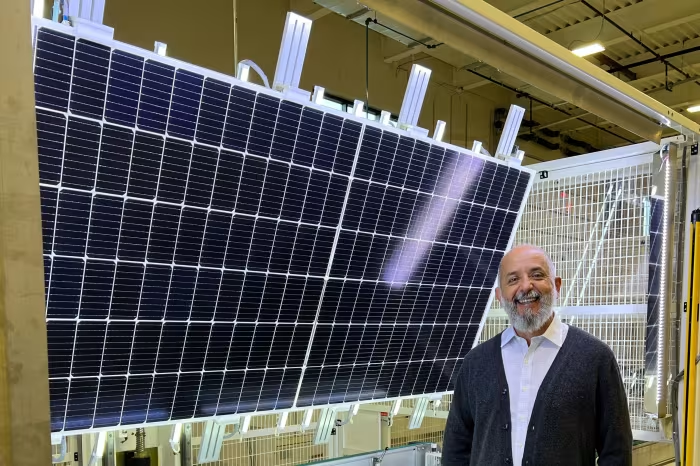Hamilton Lane joined in the $54 million growth investment to help the company build a new U.S. factory
Martin Pochtaruk, CEO of solar-module maker Heliene, at the company’s factory in Mountain Iron, Minn. Heliene plans to use a $54 million investment led by Transition Equity Partners to build a new manufacturing plant in Minnesota. Photo: HELIENE/via REUTERS
Transition Equity Partners has led an investment of as much $54 million in Canadian photovoltaic-module manufacturer Heliene, which plans to use the money to build a new factory in Minnesota.
Private-market investor Hamilton Lane also participated in the deal, along with other backers, according to Heliene.
Chicago-based Transition Equity, which backs renewable-energy developers and other businesses across the clean-energy supply chain, said government incentives that allowed Heliene to sell tax credits under the 2022 Inflation Reduction Act helped the company become “a rare opportunity” for the private-equity firm to invest in U.S. solar manufacturing.
Heliene’s planned factory in Rogers, near Minneapolis, will annually produce solar-power modules with a total capacity of 550 megawatts, or enough to power roughly 95,000 homes on average. It will lift the company’s total U.S. annual output to about 1,500 megawatts in capacity, according to Heliene.
The fresh capital builds on a $20 million investment in Heliene by other investors last year alongside $150 million in debt financing provided by Orion Infrastructure Capital, formerly known as Orion Energy Partners. Heliene needed the additional investment from Transition Equity, Hamilton Lane and the others to cover all its future plans, and operations during the intervening period demonstrated Heliene’s readiness for further expansion, according to Chief Executive Martin Pochtaruk.
“We wanted to have the results of the 2023 calendar year to show investors and be on a better footing to raise more equity,” he said.
Heliene’s revenue doubled last year from 2022, according to Pochtaruk. Revenue is expected to rise as much as 60% this year and double again next year, as supply agreements ratchet up with customers such as solar-power developer Nexamp and Excelsior Energy Capital, a private-equity firm in Excelsior, Minn., that invests in renewable-energy projects.
Heliene also recently sold roughly $50 million worth of tax credits to a corporate buyer, which showed potential investors its ability to capitalize on government clean-energy incentives, Pochtaruk added. Those include so-called 45X tax credits based on the production volume of eligible components such as Heliene’s solar modules.
“It’s an incentive [based] on volume,” Pochtaruk said of the tax credits. “It makes you manufacture more and hence [boost] growth, and we will grow thanks to the equity investments.”
Pochtaruk co-founded Heliene in 2010 in Sault Ste. Marie, Ontario, where it is still based near the eastern end of Lake Superior. The company expanded into the U.S. about seven years ago—its Mountain Iron, Minn., plant is near Superior’s western end. The new Minnesota factory is expected to come online next year.
Pinch points and supply disruptions have plagued the clean-energy industry in recent years.
Heliene this year formed a joint venture with India-based solar-cell manufacturing company Premier Energies to build another U.S. factory to produce solar cells, as part of a strategy to help overseas suppliers enter the U.S. market to prevent supply-chain bottlenecks. The plant’s location hasn’t yet been determined. Heliene last year also encouraged a Montreal-based maker of aluminum extrusions used in solar-panel frames to expand into the U.S., Pochtaruk said.
By domestically producing photovoltaic cells, or devices that convert sunlight into electricity, to make its solar modules, Heliene will help its customers benefit from government incentives tied to the use of U.S.-made equipment, Pochtaruk said. Clean-energy projects in which parts made in the U.S. represent at least 40% of the total cost of manufactured products qualify for an additional 10% tax credit under a so-called domestic-content bonus.
Heliene already buys solar cells from U.S. producer Suniva in Norcross, Ga. But the joint venture’s planned new factory will help the company increase its production to meet expected demand in the coming years, he said.
“We need to ensure that we have enough [U.S.-made] cells for our clients to continue to meet their domestic-content requirements,” he said.
U.S. solar and energy-storage companies have announced more than $100 billion in investments since the government introduced incentives for clean energy about two years ago, according to trade group Solar Energy Industries Association.
As for the risks of relying on government incentives, Pochtaruk said that while policies may change, solar equipment production will likely continue to increase along with demand.
“Governments come and go and they may change things, but the energy transition has passed the inflection point,” he said.
The main challenge for U.S. solar-panel makers and manufacturers in general isn’t potential supply-chain issues or changes in regulation, but retaining employees in the age of computers and working from home, he said.
“Convincing people to come to manufacturing jobs is more and more difficult.”
Write to Luis Garcia at luis.garcia@wsj.com
